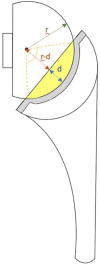Large variability in degree of constraint of reverse total shoulder arthroplasty liners between different implant systems
- PMID: 39353604
- PMCID: PMC11444795
- DOI: 10.1302/2633-1462.510.BJO-2024-0100.R1
Large variability in degree of constraint of reverse total shoulder arthroplasty liners between different implant systems
Abstract
Aims: The liner design is a key determinant of the constraint of a reverse total shoulder arthroplasty (rTSA). The aim of this study was to compare the degree of constraint of rTSA liners between different implant systems.
Methods: An implant company's independent 3D shoulder arthroplasty planning software (mediCAD 3D shoulder v. 7.0, module v. 2.1.84.173.43) was used to determine the jump height of standard and constrained liners of different sizes (radius of curvature) of all available companies. The obtained parameters were used to calculate the stability ratio (degree of constraint) and angle of coverage (degree of glenosphere coverage by liner) of the different systems. Measurements were independently performed by two raters, and intraclass correlation coefficients were calculated to perform a reliability analysis. Additionally, measurements were compared with parameters provided by the companies themselves, when available, to ensure validity of the software-derived measurements.
Results: There were variations in jump height between rTSA systems at a given size, resulting in large differences in stability ratio between systems. Standard liners exhibited a stability ratio range from 126% to 214% (mean 158% (SD 23%)) and constrained liners a range from 151% to 479% (mean 245% (SD 76%)). The angle of coverage showed a range from 103° to 130° (mean 115° (SD 7°)) for standard and a range from 113° to 156° (mean 133° (SD 11°)) for constrained liners. Four arthroplasty systems kept the stability ratio of standard liners constant (within 5%) across different sizes, while one system showed slight inconsistencies (within 10%), and ten arthroplasty systems showed large inconsistencies (range 11% to 28%). The stability ratio of constrained liners was consistent across different sizes in two arthroplasty systems and inconsistent in seven systems (range 18% to 106%).
Conclusion: Large differences in jump height and resulting degree of constraint of rTSA liners were observed between different implant systems, and in many cases even within the same implant systems. While the immediate clinical effect remains unclear, in theory the degree of constraint of the liner plays an important role for the dislocation and notching risk of a rTSA system.
© 2024 Moroder et al.
Conflict of interest statement
P. Moroder is a consultant and receives royalties from Arthrex and Medacta, unrelated to this study. All other authors have no conflicts of interest to disclose.
Figures




Similar articles
-
Do constrained liners (in a 145° onlay implant) provide any benefit? A matched retrospective study.J Shoulder Elbow Surg. 2025 May;34(5):1158-1165. doi: 10.1016/j.jse.2024.08.042. Epub 2024 Oct 19. J Shoulder Elbow Surg. 2025. PMID: 39427727
-
No difference in range of motion in reverse total shoulder arthroplasty using standard or constrained liners: a matched cohort study.JSES Int. 2022 Aug 10;6(6):929-934. doi: 10.1016/j.jseint.2022.07.004. eCollection 2022 Nov. JSES Int. 2022. PMID: 36353430 Free PMC article.
-
Reverse total shoulder arthroplasty polyethylene percentage capture: a descriptive analysis of commercially available reverse shoulder arthroplasty systems.J Shoulder Elbow Surg. 2025 Apr 19:S1058-2746(25)00337-4. doi: 10.1016/j.jse.2025.03.016. Online ahead of print. J Shoulder Elbow Surg. 2025. PMID: 40258531
-
Effect of scapular notching on clinical outcomes after reverse total shoulder arthroplasty.Bone Joint J. 2020 Nov;102-B(11):1438-1445. doi: 10.1302/0301-620X.102B11.BJJ-2020-0449.R1. Bone Joint J. 2020. PMID: 33135432 Free PMC article.
-
The Influence of Reverse Total Shoulder Arthroplasty Implant Design on Biomechanics.Curr Rev Musculoskelet Med. 2023 Mar;16(3):95-102. doi: 10.1007/s12178-023-09820-8. Epub 2023 Feb 3. Curr Rev Musculoskelet Med. 2023. PMID: 36735182 Free PMC article. Review.
Cited by
-
From Grammont to a New 135° Short-Stem Design: Two-Hand Lever Test and Early Superior-Lateral Dislocations Reveal Critical Role of Liner Stability Ratio and Stem Alignment.J Clin Med. 2025 Mar 11;14(6):1898. doi: 10.3390/jcm14061898. J Clin Med. 2025. PMID: 40142706 Free PMC article.
-
Mid-Term Outcomes of a Rectangular Stem Design with Metadiaphyseal Fixation and a 135° Neck-Shaft Angle in Reverse Total Shoulder Arthroplasty.J Clin Med. 2025 Jan 16;14(2):546. doi: 10.3390/jcm14020546. J Clin Med. 2025. PMID: 39860550 Free PMC article.
References
LinkOut - more resources
Full Text Sources

